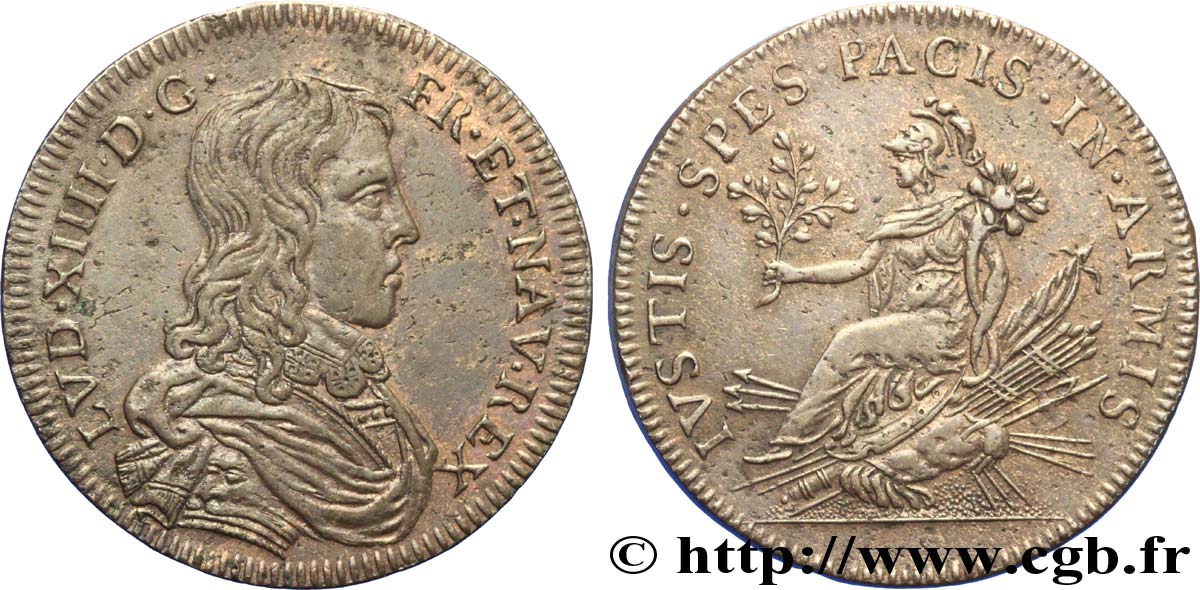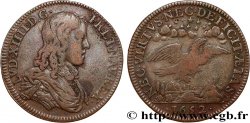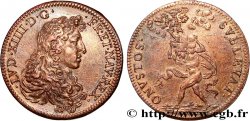E-auction 91-47118 - fjt_257679 - LOUIS XIV THE GREAT or THE SUN KING Préliminaires de la Paix de Munster n.d.
You must signin and be an approved bidder to bid, LOGIN TO BID. Accounts are subject to approval and the approval process takes place within 48 hours. Do not wait until the day a sale closes to register. Clicking on « bid » constitutes acceptance of the terms of use of cgb.fr private e-auctions.
Bids must be placed in whole Euro amounts only. The sale will start closing at the time stated on the item description; any bids received at the site after the closing time will not be executed. Transmission times may vary and bids could be rejected if you wait until the last second. For further information ckeck the E-auctions F.A.Q.
NO BUYER'S FEE.
NO BUYER'S FEE.
| Estimate : | 65 € |
| Price : | 31 € |
| Maximum bid : | 57 € |
| End of the sale : | 12 January 2015 19:01:30 |
| bidders : | 7 bidders |
Type : Préliminaires de la Paix de Munster
Date: n.d.
Metal : red copper
Diameter : 27 mm
Orientation dies : 6 h.
Edge : lisse
Rarity : R1
Catalogue references :
Obverse
Obverse legend : LVD. XIIII. D. G. FR. ET. NAV. REX.
Obverse description : Buste de Louis XIV, type Guéant Prieur 218G.
Reverse
Reverse legend : IVSTIS. SPES. - PACIS. IN. ARMIS. .
Reverse description : La Paix ou la France assise à gauche sur des armes, tenant une branche de laurier et une corne d'abondance.
Reverse translation : L'espoir de Paix repose sur les armes.
Commentary
C’est cet exemplaire qui illustre le type de buste dans le Guéant Prieur.
Suite au Traité de Munster, a France est confirmée dans la possession des Trois-Évêchés de Metz, Toul et Verdun annexés de fait depuis un siècle.
La maison d'Autriche lui cède tous les droits qu'elle possède sur l'Alsace, c'est-à-dire les landgraviats d'Alsace ;
Le Sundgau, comprenant : le comté de Ferrette ; les seigneuries dites médiatisées, à savoir : les seigneuries des Reinach (Montjoie et Hattstatt), des Ribeaupierre (Ribauvillé, Zellenberg, Guémar, Wihr-au-Val, Orbey, la moitié de Sainte-Marie-aux-Mines et Heiteren), de Bollwiller et d'Issenheim ; les terres dites engagées, à savoir : la seigneurie de Hohandsberg, des Schendi ; celle de Hokœnigsbourg et le val de Villé ; la place-forte de Brisach, sur la rive droite du Rhin, et ses dépendances : Hochstetten, Niederrimsingen, Hartheim et Achkarren ainsi que, sur la rive gauche, Biesheim ; Philippsburg ; les droits de bailli sur dix villes de l'empire en Alsace sans Strasbourg ni Mulhouse.
La France annexe la forteresse de Pignerol, dans le Piémont, et Moyenvic, en Lorraine.
De nombreux princes allemands conservent des fiefs en Alsace avant son rattachement à la France. Le traité stipule que leurs possessions ne dépendent pas du droit français mais de celui du Saint Empire romain germanique.
Avec le traité de Münster, la France atteint son but qui est d'agrandir durablement le royaume. L'empereur perd le droit de mener la politique extérieure de l'Empire. Celle-ci est désormais soumis à l'accord du Reichstag. Pour plus de précisions, voir https://fr.wikipedia.org/wiki/Trait%C3%A9_de_M%C3%BCnster.
Suite au Traité de Munster, a France est confirmée dans la possession des Trois-Évêchés de Metz, Toul et Verdun annexés de fait depuis un siècle.
La maison d'Autriche lui cède tous les droits qu'elle possède sur l'Alsace, c'est-à-dire les landgraviats d'Alsace ;
Le Sundgau, comprenant : le comté de Ferrette ; les seigneuries dites médiatisées, à savoir : les seigneuries des Reinach (Montjoie et Hattstatt), des Ribeaupierre (Ribauvillé, Zellenberg, Guémar, Wihr-au-Val, Orbey, la moitié de Sainte-Marie-aux-Mines et Heiteren), de Bollwiller et d'Issenheim ; les terres dites engagées, à savoir : la seigneurie de Hohandsberg, des Schendi ; celle de Hokœnigsbourg et le val de Villé ; la place-forte de Brisach, sur la rive droite du Rhin, et ses dépendances : Hochstetten, Niederrimsingen, Hartheim et Achkarren ainsi que, sur la rive gauche, Biesheim ; Philippsburg ; les droits de bailli sur dix villes de l'empire en Alsace sans Strasbourg ni Mulhouse.
La France annexe la forteresse de Pignerol, dans le Piémont, et Moyenvic, en Lorraine.
De nombreux princes allemands conservent des fiefs en Alsace avant son rattachement à la France. Le traité stipule que leurs possessions ne dépendent pas du droit français mais de celui du Saint Empire romain germanique.
Avec le traité de Münster, la France atteint son but qui est d'agrandir durablement le royaume. L'empereur perd le droit de mener la politique extérieure de l'Empire. Celle-ci est désormais soumis à l'accord du Reichstag. Pour plus de précisions, voir https://fr.wikipedia.org/wiki/Trait%C3%A9_de_M%C3%BCnster.








 Report a mistake
Report a mistake Print the page
Print the page Share my selection
Share my selection Ask a question
Ask a question Consign / sell
Consign / sell
 Full data
Full data



